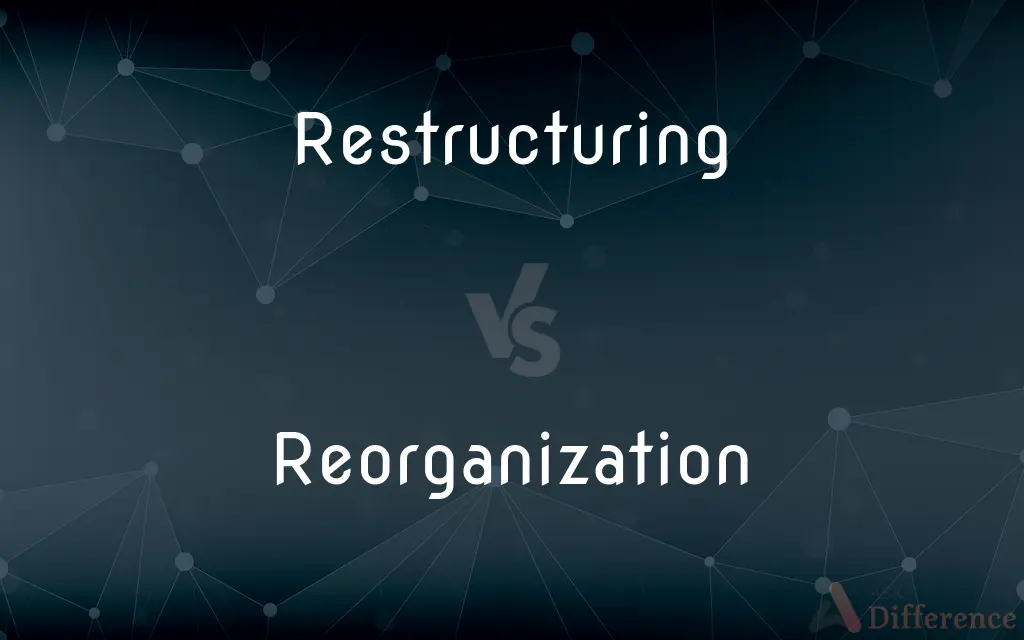Restructuring vs. Reorganization — What's the Difference?
Edited by Tayyaba Rehman — By Fiza Rafique — Updated on March 16, 2024
Restructuring involves changing the operational, financial, or legal aspects of a company to improve efficiency, while reorganization often refers to legal processes under bankruptcy law to restructure a company's debt and operations.

Difference Between Restructuring and Reorganization
Table of Contents
ADVERTISEMENT
Key Differences
Restructuring is a comprehensive process that companies undertake to significantly modify their financial, operational, or organizational structures. This can include changes in business processes, management hierarchies, employment arrangements, and financial strategies to enhance efficiency and profitability. Whereas, reorganization often involves a legal procedure, especially under bankruptcy laws, where a company restructures its debts and operations to remain viable and continue its business operations.
While restructuring might be initiated internally to address inefficiencies, adapt to new markets, or improve competitiveness without the immediate pressure of insolvency, reorganization is frequently a response to financial distress, involving legal proceedings to ensure equitable debt repayment and organizational restructuring under the supervision of a court. This distinction highlights how the objectives and immediacy of action differ between the two, with restructuring being more proactive and reorganization reactive.
Restructuring can occur in various aspects of a company, including layoffs, selling off underperforming divisions, outsourcing, changing internal business processes, or altering corporate governance structures. These actions aim at improving operational efficiency and financial health on a broad scale. On the other hand, reorganization specifically targets the alteration of the company’s debt structure, often including negotiations with creditors, to achieve a more manageable debt load, while potentially also modifying operational aspects to increase profitability and sustainability.
The scope of restructuring is generally broader, potentially encompassing changes in strategy, operations, culture, and finances, tailored to strategic goals beyond immediate survival. In contrast, reorganization is narrower, primarily focused on financial survival in the short term, often within the framework of legal protections from creditors, which might limit the company’s operational flexibility.
Despite their differences, both restructuring and reorganization aim to ensure the company’s long-term survival and growth. While restructuring may be part of a strategic initiative to head off future problems or capitalize on new opportunities, reorganization is typically a forced adaptation to current, often severe, financial challenges.
ADVERTISEMENT
Comparison Chart
Definition
Changing operational, financial, or legal structures.
Legal process under bankruptcy law to restructure debt and operations.
Purpose
Improve efficiency, adapt to market changes, enhance profitability.
Resolve financial distress, continue business operations.
Initiation
Can be voluntary or as a strategic decision.
Often initiated due to financial distress, under legal proceedings.
Scope
Broad, can include operational, financial, and organizational changes.
Narrower, focused on financial restructuring within legal constraints.
Process
May involve internal changes, strategy shifts, layoffs, divestitures.
Involves legal proceedings, debt negotiation, possible operational restructuring.
Compare with Definitions
Restructuring
A process aimed at improving a company's efficiency, financial health, or organizational effectiveness.
The company initiated a restructuring plan that included layoffs and the sale of non-core assets.
Reorganization
A legal process to restructure a company's debts and operations under bankruptcy laws.
Facing insolvency, the company filed for Chapter 11 to begin the reorganization process.
Restructuring
To enhance competitiveness and ensure long-term profitability.
The goal of restructuring was to position the company better against its competitors.
Reorganization
Seeks to provide a company with a fresh start by resolving financial issues.
After completing the reorganization, the company emerged leaner and more financially stable.
Restructuring
Can affect any aspect of the company, from operations to finances.
The restructuring effort resulted in streamlined operations and a more focused business strategy.
Reorganization
Primarily focuses on financial restructuring, though it may include operational adjustments.
The reorganization plan included debt repayment schedules and operational downsizing.
Restructuring
Aims at improving overall performance and shareholder value.
Post-restructuring, the company reported an increase in efficiency and a stronger financial position.
Reorganization
Triggered by financial challenges, requiring court involvement.
Unable to meet its debt obligations, the company sought legal recourse for reorganization.
Restructuring
Often undertaken proactively to address potential issues or opportunities.
Seeing a shift in market demand, the company embarked on a restructuring to capitalize on new trends.
Reorganization
To survive financial distress and continue business operations.
The reorganization aimed to keep the company afloat during tough economic times.
Restructuring
Restructuring is the corporate management term for the act of reorganizing the legal, ownership, operational, or other structures of a company for the purpose of making it more profitable, or better organized for its present needs. Other reasons for restructuring include a change of ownership or ownership structure, demerger, or a response to a crisis or major change in the business such as bankruptcy, repositioning, or buyout.
Reorganization
The act or process of organizing again or differently.
Restructuring
To alter the makeup or pattern of
"serious efforts to restructure third world debt" (Felix Rohatyn).
Reorganization
A thorough alteration of the structure of a business corporation.
Restructuring
To make a basic change in (an organization or a system, for example).
Reorganization
The act or process of rearranging. See reorganize.
Restructuring
To alter the structure of something.
Reorganization
The end result of such an act.
Restructuring
Present participle of restructure
Reorganization
The act of reorganizing; a reorganized existence; as, reorganization of the troops.
Restructuring
A reorganization; an alteration of structure.
Reorganization
The act of imposing a new organization; organizing differently (often involving extensive and drastic changes);
A committee was appointed to oversee the reorganization of the curriculum
Top officials were forced out in the cabinet shakeup
Reorganization
An extensive alteration of the structure of a corporation or government;
After the takeover there was a thorough reorganization
The reorganization was prescribed by federal bankruptcy laws
Common Curiosities
Is reorganization always related to bankruptcy?
Reorganization often occurs in the context of bankruptcy, providing a legal framework to restructure debts and operations, although the term can sometimes be used more broadly.
What triggers a company to undergo restructuring or reorganization?
Restructuring is often triggered by a desire to improve efficiency or adapt to market changes, while reorganization is triggered by financial distress requiring legal intervention.
Can restructuring involve legal processes?
While restructuring can involve legal processes, especially in altering legal structures or dealing with layoffs, it is not inherently a legal procedure like reorganization under bankruptcy law.
Can a company choose restructuring over reorganization?
Yes, companies may choose restructuring as a proactive measure to avoid financial distress that could lead to reorganization under bankruptcy.
What is the impact of restructuring or reorganization on employees?
Both processes can affect employees through layoffs, changes in job roles, or shifts in corporate culture, but the specifics depend on the company’s strategy and financial condition.
How long do restructuring and reorganization processes take?
The duration varies widely depending on the complexity of the situation, with restructuring potentially being quicker if initiated proactively, while reorganization can be lengthy due to legal proceedings.
How do stakeholders benefit from restructuring or reorganization?
Successful restructuring or reorganization can lead to a more viable and financially stable company, potentially benefiting all stakeholders in the long term.
Can restructuring lead to reorganization if unsuccessful?
Yes, if restructuring efforts are insufficient to solve financial issues, a company may subsequently need to undergo reorganization to address deeper financial distress.
Do restructuring and reorganization affect company ownership?
Ownership can be affected, especially in reorganization, where debt might be converted to equity, diluting or changing the composition of ownership.
Are there alternatives to reorganization under bankruptcy?
Alternatives can include out-of-court debt restructuring, refinancing, or seeking private equity investment to avoid the formal reorganization process.
How do creditors influence the reorganization process?
Creditors play a significant role in reorganization, as they must often agree to new terms, including debt repayment schedules or reductions, as part of the legal process.
What are the signs a company might need restructuring or reorganization?
Signs include declining profits, operational inefficiencies, increasing debt, and inability to meet financial obligations.
Share Your Discovery

Previous Comparison
Teachable vs. Trainable
Next Comparison
Cerebrum vs. CerebellumAuthor Spotlight
Written by
Fiza RafiqueFiza Rafique is a skilled content writer at AskDifference.com, where she meticulously refines and enhances written pieces. Drawing from her vast editorial expertise, Fiza ensures clarity, accuracy, and precision in every article. Passionate about language, she continually seeks to elevate the quality of content for readers worldwide.
Edited by
Tayyaba RehmanTayyaba Rehman is a distinguished writer, currently serving as a primary contributor to askdifference.com. As a researcher in semantics and etymology, Tayyaba's passion for the complexity of languages and their distinctions has found a perfect home on the platform. Tayyaba delves into the intricacies of language, distinguishing between commonly confused words and phrases, thereby providing clarity for readers worldwide.















































